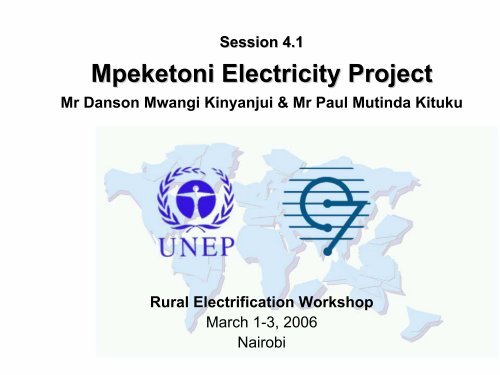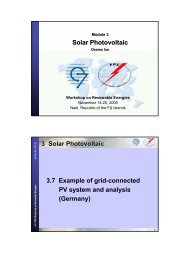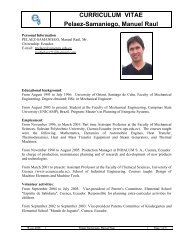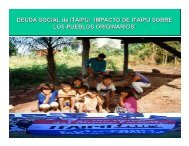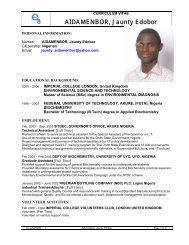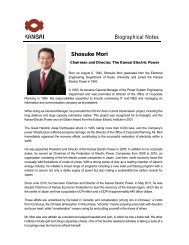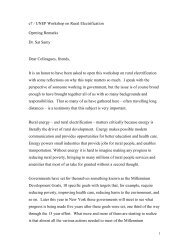Case study: Mpeketoni Electricity Project
Case study: Mpeketoni Electricity Project
Case study: Mpeketoni Electricity Project
You also want an ePaper? Increase the reach of your titles
YUMPU automatically turns print PDFs into web optimized ePapers that Google loves.
Session 4.1<br />
<strong>Mpeketoni</strong> <strong>Electricity</strong> <strong>Project</strong><br />
Mr Danson Mwangi Kinyanjui & Mr Paul Mutinda Kituku<br />
Rural Electrification Workshop<br />
March 1-3, 2006<br />
Nairobi
<strong>Mpeketoni</strong> <strong>Electricity</strong> <strong>Project</strong><br />
e7 / UNEP Rural Electrification Workshop Nairobi<br />
• Community Based<br />
<strong>Electricity</strong> <strong>Project</strong><br />
• Independent of Subsidies<br />
• High demand<br />
• High tariffs<br />
• Constrained by rising cost<br />
of production<br />
2
<strong>Mpeketoni</strong> Overview<br />
• <strong>Mpeketoni</strong> is part of a resettlement programme<br />
initiated in the 1970s in an area with high agricultural<br />
potential.<br />
e7 / UNEP Rural Electrification Workshop Nairobi<br />
• It is located of the Northern coast of Kenya, 230km<br />
north of Malindi and 60km from Lamu island.<br />
• The scheme covers about 38000acres and has a<br />
population of about 31000<br />
• Agriculture is the main source of income in the<br />
settlement scheme. Crops grown include cashewnuts,<br />
cotton, maize, bananas, bixa and simsim.<br />
• In addition, a number of fruit and horticulture crops<br />
are grown for sale in Lamu and Mombasa markets.<br />
3
•Coast of Kenya<br />
•Lamu District<br />
4<br />
<strong>Mpeketoni</strong> - Location<br />
e7 / UNEP Rural Electrification Workshop Nairobi
e7 / UNEP Rural Electrification Workshop Nairobi<br />
<strong>Mpeketoni</strong> <strong>Electricity</strong> <strong>Project</strong><br />
(MEP)<br />
(MEP) • Diesel-fired electricity<br />
generation and distribution<br />
system<br />
• Isolated from national grid<br />
• Established in 1993<br />
– Ksh534,000 (US$7,500) is<br />
raised towards the<br />
project through the sale<br />
of 178 individual shares<br />
to the public<br />
– community also provides<br />
the land<br />
– GTZ contributes a<br />
generator house, office<br />
construction, generation<br />
and transmission<br />
equipment and starting<br />
capital<br />
– Land provided by<br />
Government<br />
5
MEP History<br />
• 1994 - <strong>Project</strong> starts to generate electricity, the<br />
system comprises a 60KVA generator and a 4km<br />
network serving 75 single-phase connections and 15,<br />
3-phase connections.<br />
e7 / UNEP Rural Electrification Workshop Nairobi<br />
• 1996 - A 57kVA generator is added<br />
• 1999 - Due to increased demand a 150kVA generator is<br />
added and carries the major load to date.<br />
• 2004 - <strong>Project</strong> is handed over to the community.<br />
• 2005 - <strong>Project</strong> has 220 single-phase connections and<br />
20, 3-phase connections<br />
6
MEP Consumers<br />
• about 130 shops, over 90<br />
households, 4 flourmills, and<br />
a number of garages,<br />
workshops and small-scale<br />
industries.<br />
e7 / UNEP Rural Electrification Workshop Nairobi<br />
• several larger industries and<br />
key services such as a subdistrict<br />
hospital, secondary<br />
school, and the Government<br />
offices.<br />
• Connections made on the<br />
<strong>Mpeketoni</strong> grid reach about<br />
4% of the families in the Lake<br />
Kenyatta settlement scheme<br />
•Total demand can peak<br />
at roughly 200 kW (which<br />
is near the limit of the<br />
system’s capacity) and<br />
totals about kWh 190,000<br />
per year<br />
7
Tariffs<br />
USc/kWh<br />
40<br />
30<br />
20<br />
10<br />
0<br />
1994 1999 2004<br />
• Increase in<br />
electricity tariffs<br />
since 1994.<br />
e7 / UNEP Rural Electrification Workshop Nairobi<br />
• MEP’s tariffs in<br />
comparison to others<br />
in the region (USc)<br />
Year<br />
USc/kWh<br />
40<br />
35<br />
30<br />
25<br />
20<br />
15<br />
10<br />
5<br />
0<br />
MEP Kenya Tanzania Uganda South Africa<br />
8
Constraints to Operation and<br />
Expansion<br />
e7 / UNEP Rural Electrification Workshop Nairobi<br />
• The rising price of diesel<br />
fuel.<br />
• High cost of maintenance of<br />
the system components<br />
• Power quality and reliability<br />
• High connection costs<br />
• Rising power demand within<br />
and outside the township<br />
9
E7 and MEP<br />
• E7 identified MEP in 2004 as a result of a scoping <strong>study</strong> to<br />
identify and develop an off-grid demonstration renewable energy<br />
project<br />
• Potential for investment in wind energy to reduce generation<br />
costs and tariff<br />
e7 / UNEP Rural Electrification Workshop Nairobi<br />
• Some of the activities undertaken include:<br />
– Wind data collection since December 2004<br />
– A feasibility <strong>study</strong><br />
• examine opportunities for utilizing the local wind<br />
resource to providing extra capacity to the existing<br />
system and drawn down the cost of generation.<br />
• Upgrading of existing grid to increase security of supply<br />
and improve quality of supply (eg soft start panels on<br />
grain mills)<br />
• Reduce costs for connection utilizing low cost<br />
electrification techniques<br />
10
Next Steps<br />
• MEP to receive 2 x300kVA generators from<br />
Government of Kenya Ministry of Energy – discussions,<br />
logistics and EIA facilitated by e7<br />
e7 / UNEP Rural Electrification Workshop Nairobi<br />
• E7 to review feasibility and agree programme for<br />
upgrading of distribution network<br />
• International tender underway for purchase and<br />
installation of wind turbines.<br />
• Financial structure to be finalised<br />
11


